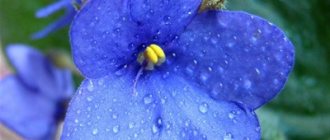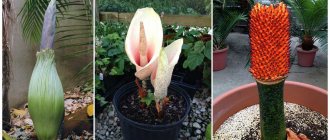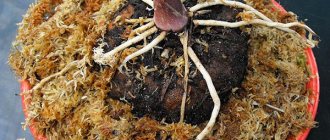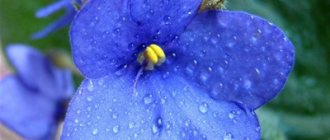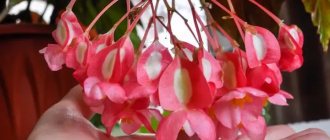Amorphophallus is an exotic herbaceous plant from the aroid family. It is also popularly known as “Voodoo Lily” and “Snake Palm”.
Amorphophallus is native to the tropics of India and Sumatra. The plant is a typical ephemeroid. It spends most of its life in a state of rest. After awakening, amorphophallus throws out one single leaf on a long petiole, the height of which can reach 1.5 meters. Large tubers of amorphophallus are edible. They are widely used in traditional Japanese cuisine to prepare a number of dishes. In China they are used as a dietary product. The jelly-like substances they contain effectively reduce cholesterol and blood sugar levels.
If you like to grow carnivorous plants at home, then watch how to grow nepenthes.
| The growth rate is very high. A whole leaf can grow in a year. |
| Blooms at home after a period of dormancy. |
| The plant is easy to grow. |
| It is a perennial plant, but after flowering all the above-ground parts die. |
Main characteristics and photos of amorphophallus
The humid tropics of China and India are considered the homeland of this flower, but various species can be found in the tropical and subtropical regions of Africa, Asia, Australia and many Pacific islands.
From Greek amorpho is translated as shapeless, phallus - phallus
Amorphophallus is a deciduous plant of the Araceae family. From the Greek amorpho is translated as shapeless, phallus - phallus. The plant belongs to the ephemeroids - in the dormant stage for a long time. In a short growing season, amorphophallus manages to bloom, grow leaves, shed them and go to rest. Apparently, due to this quality, as well as the fact that the blooming flower emits a very unpleasant smell of spoiled meat, this plant is not particularly popular among gardeners.
In a short growing season, amorphophallus manages to bloom, grow leaves, shed them and go on vacation
Phases of flower development
The genus Amorphophallus has about a hundred species of plants, very different in size, with flower stalks from 30 cm to 5 meters. These plants develop from tubers similar to beets, weighing up to 90 kg in some species. The tuber is dormant for about six months. The above-ground part of the plant consists of a single thick shoot, on which a powerful, strongly dissected leaf develops, and the flower becomes like a palm tree. In indoor conditions, the leaf unfolds most often in April. The amorphophallus remains in this state until October, then the shoot turns yellow and dies, and the plant begins a dormant period. In the spring of next year, a new leaf will appear, larger and taller than the previous one and with a more dissected leaf blade.
It's hard to believe that this tree is an amorphophallus leaf
Amorphophallus blooms after waking up and before the leaf appears. Flowering is short-lived, usually about two weeks. At this time, the tuber greatly decreases in size, having spent its nutrient reserves on the development of the flower. After flowering ends, a short period of dormancy begins. Within three to four weeks, the plant recovers and produces another leaf.
If pollination occurs during flowering, then fleshy fruits with seeds will appear in the lower part of the amorphophallus cob. After the fruits ripen, the plant dies. When growing indoors, pollination is very difficult to achieve - for this to happen, at least two plants of the same species must bloom at the same time.
Reproduction
Often, the “children” method is chosen for propagation. They appear near the leaf of an adult crop. If the growing conditions are favorable for the plant, then in one season the children can reach the size of the crop itself.
Amorphophallus can be propagated by another method. Many gardeners don’t even know that this method exists.
During the active period of the flower, a small process is located near the leaf (more precisely, near its divergences). It is barely noticeable, so housewives often do not notice it.
- When the leaf begins to dry out and the plant goes dormant, this tuber is separated from the mother trunk. The place that was attached to the leaf is dried.
- Plant the tuber in a small container. A sprout may appear instantly, or it may only do so in the spring. Each process behaves differently.
After reproduction, amorphophallus will develop within five years. It will begin to bloom only after complete adaptation. For this, the flower requires more time. Within five years, one leaf will form on the trunk. Sizes will be added annually.
After the culture is saturated with nutrients, the tuber grows up to thirty centimeters, and the first inflorescences begin to appear.
Features of indoor maintenance
Amorphophallus is easy to grow indoors. There are no special requirements for maintenance - warmth during the growing season, bright diffused light and slightly increased air humidity.
Video: description of amorphophallus
Types of amorphophallus
Despite the large number of species of amorphophallus, only a few of them are used in indoor floriculture.
Cognac
Amorphophallus konjac is a perennial plant grown from a tuber, also often found under the name Amorphophallus rivieri (rivieri). In China, Japan and some other countries it is grown as an edible plant. Various dishes are prepared from its dried and crushed tubers - soups, side dishes and seasonings. Due to its ability to reduce blood sugar and cholesterol, it is used in dietary nutrition for various gastrointestinal diseases and obesity.
The inflorescence of amorphophallus cognac consists of a long burgundy-violet spadix, framed by a petal-veil. Female and male flowers are formed in the lower part of the peduncle, while the crown remains sterile. When grown in pots, the inflorescence often reaches a height of 80 cm. The green leaf that appears after flowering is highly dissected, with many small pointed leaf segments attached to a hollow petiole, shaped like an umbrella. Every autumn the leaf dies, and after a period of dormancy a new one grows - slightly higher than the previous one and more dissected. Under indoor conditions, the leaf height and crown diameter usually do not exceed one meter.
Feeding
It is recommended to fertilize amorphophallus in the summer, when the plant has already grown well. Phosphorus must predominate in the fertilizer (for tuber growth), and the presence of nitrogen and potassium .
The plant responds well to organic fertilizers , in particular, to feeding with liquid mullein.
Mineral and organic fertilizing should be alternated.
Feeding should be mandatory, especially for flowering plants.
Fertilizers are applied only to moist, well-watered and slightly dried soil. Applying fertilizers to dry soil can burn the roots.
Amorphophallus blooming in the apartment
Features of transplantation
Planting and replanting of amorphophallus is carried out during the dormant period. The tuber is planted as soon as sprouts begin to emerge. This usually happens in late February - early March. For planting, take a plastic or ceramic pot twice the size of the tuber. The shape of the pot is important, because as the tuber grows, roots will form on its upper part, which will need to be covered with soil. Therefore, it is better to choose a deep container. It is necessary to lay drainage at the bottom with a layer of 2–3 cm - expanded clay, pebbles or crushed brick.
You can buy ready-made soil for aroid plants or prepare it yourself. To do this, take equal quantities of leaf soil, turf, humus, peat or coconut substrate and sand and mix well. The acidity of the resulting mixture should be neutral or slightly acidic.
Amorphophallus tubers with sprouting sprouts can be planted in the ground
Step by step planting process:
- Place a 5–6 cm layer of soil on the drainage.
- Place the tuber in the pot with the sprouts facing up.
- Sprinkle with soil so that the sprouts are on the surface and there is 7-8 cm left to the edge of the pot.
- Lightly compact the soil.
- Carefully water the soil around the edge of the pot with soft, settled water, being careful not to flood the tuber from above.
- Place the pot in a well-lit place, without direct sunlight.
If you purchased amorphophallus at the stage of peduncle development, then it is not advisable to replant it. You can place the pot in a beautiful flowerpot and don’t forget to add soil as the tuber grows. If the purchased plant is in a container that is too small to allow the tuber to develop, you can carefully transplant it into a larger container by transferring it without disturbing the earthen ball.
Preparing for rest
The fall of the aerial part signals a state of dormancy. The pots are moved to a moderately cold, shady place. A number of florists advise digging up nodules for storage outside the pot.
- Features of choosing flower seeds
Gardena garden equipment
Wedding decorated in green
Take a look at the dug up tuber and check for rot. Cut off the damaged areas, dry the sections and sprinkle with charcoal.
For storage, choose a dry, not too hot place. For planting, use a soil mixture of peat, humus, leaf soil, and sand in equal proportions.
Subtleties of care at home
Caring for amorphophallus when growing in pots is simple and consists of timely watering and fertilizing, providing slightly increased air humidity and proper organization of the dormant period.
Watering and fertilizing
From the moment the sprout appears until the leaf turns yellow, the amorphophallus is watered regularly, trying to avoid water getting on the tuber. You can use bottom watering - place the pot in a container with settled water for 20 minutes. During this time, the soil will be moistened, the pot can be pulled out, allowed to drain and placed on a tray. As the leaves begin to wilt, watering should be reduced and watered only as the earthen clod dries out.
To flower, amorphophallus needs regular feeding. Fertilizers can be applied after the sprout appears or after rooting, if transplantation was carried out. Amorphophallus requires a high phosphorus content to flower, so Agricola for flowering plants can be applied in liquid form once every two weeks. This preparation contains microelements in proportions most suitable for corm flowers. To increase the phosphorus content, you can add double superphosphate to the Agricola solution (for 3 liters of water, 1 teaspoon of Agricola and 1 teaspoon of double superphosphate). It is advisable to alternate mineral fertilizers with organic ones. Liquid universal fertilizer Ideal, due to its high phosphorus content, is a completely suitable option for amorphophallus.
Fertilizing should be applied only after the main watering, on wet soil. Do not fertilize sick, damaged or newly transplanted plants.
Flowering period of amorphophallus
If all growing conditions are met, amorphophallus blooms, as a rule, in March. Flowering lasts two weeks, after which the wilted flower can be cut off. A short period of rest ensues. At this time, the tuber replenishes the energy spent on flowering and prepares to continue its growth. At this time, watering is slightly reduced, and feeding begins when the leaf appears.
Typical gardener mistakes
The main problems for a novice gardener are related to the need to adjust watering. In soil turned into a swamp, the amorphophallus tuber quickly rots. Other errors in care negatively affect the decorative appearance of a single leaf.
Table: how errors in care manifest themselves and what causes them
| What does the plant look like? | What is the reason |
| Quickly spreading black “wetting” spots on the tuber and at the base of the petiole. | Too frequent and/or excessive watering. The situation is aggravated by low indoor temperatures. |
| Drying leaf. | The plant does not have enough fertilizer or the air in the room is too dry. |
| Darkened leaf. | The flower does not have enough light. Sometimes it is placed in partial shade specifically to achieve this effect. |
| Light spots of irregular shape on the leaf. | Amorphophallus received sunburn. This happens especially often if a freshly sprayed plant is standing in the sun - drops of water focus the rays. |
Diseases and pests
Amorphophallus, when kept indoors, is not susceptible to any diseases, and among pests it can sometimes be affected by aphids or spider mites. To prevent the appearance of aphids, you need to ensure that the pot with amorphophallus does not end up next to infected plants.
Aphids, settling on petioles and leaves, draw juice from the plant
Spider mites most often appear when the air is dry. The surface of the leaf is covered with small whitish dots, and on the lower part of the leaf blade you can see small mites and cobwebs. To avoid the appearance of this pest, it is necessary to spray the plant with water more often and try to increase air humidity by all means.
Spider mites appear when there is insufficient air humidity and greatly weaken the plant.
Fitoverm, a microbiological preparation, helps to cope with aphids and spider mites. Prepare the solution as described in the instructions and spray the plant twice, with an interval of 10 days.
Sometimes, due to excessive watering, midges can settle on the soil surface . You can also get rid of them using Fitoverm, you just need to spray the soil in the pot with the drug.
Common types
The giant flower has many varieties. The main ones include the following.
Amorphophallus titanica
Amorphophallus indoor flower - home care
Amorphophallus titanum is a fairly tall and very large flower. Its tuber, which looks a little like a potato, can reach 20 kg in weight. The spadix of this plant species can reach up to two meters in height and has a burgundy fleshy inflorescence.
Among gardeners, Amorphophallus Titanium is a fairly common species, but keeping it at home will not work due to the plant’s too large size.
Curious. There are many interesting facts about Amorphophallus titanica. For example, in Asian countries this smelly plant is used as food. It is often used to add to soup. The tubers are used to make flour for noodles. In this regard, in many Asian countries it is called elephant bread.
Amorphophallus Cognac
The flower of amorphophallus konjac is otherwise called amorphophallus peonyleaf. It has relatively modest dimensions and a flattened tuber shape. The latter are about 20 cm in diameter. The length of the peduncle is about 60 cm, the length of the cob is 50 cm. The inflorescence has a purple-burgundy tint.
The Cognac variety has more compact dimensions
Amorphophallus bulbiferous
Bulbous, or bulbous amorphophallus is most suitable for the role of a houseplant, since it is particularly compact in size. The adult flower continues to grow to only half a meter in length. This species is characterized by a soft pink color and an inflorescence no higher than 30 cm in height.
Amorphophallus Rivera
Another variety that can be grown as a houseplant is Rivera. It grows up to 1 meter. But this amorphophallus flower blooms much more often when planted at home. The truth never bears fruit.

